Comet Lovejoy Is Visible Near Earth’s Horizon In This Nighttime Image Photographed By NASA Astronaut
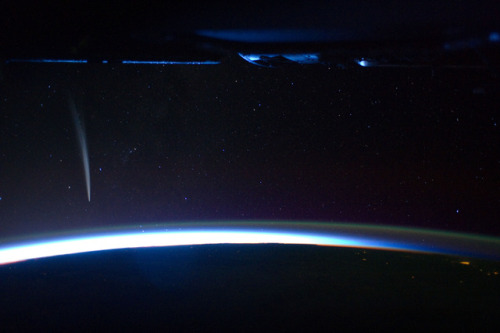
Comet Lovejoy is visible near Earth’s horizon in this nighttime image photographed by NASA astronaut Dan Burbank, Expedition 30 commander, onboard the International Space Station on Dec. 21, 2011.
Image credit: NASA
More Posts from Xyhor-astronomy and Others

Black Holes are not so Black (Part 3) - Gravitational Waves
The existence of Gravitational Waves have been confirmed. But you probably have heard that. In this post, we will break down this profound discovery into comprehend-able chunks.
This is going to be a amazing journey. Ready ?
Redefining Gravity
When we usually talk of Gravitation we are bound to think like Newton, where objects are assumed to exerting a force upon each other.
Like imaginary arrows of force in space. But this picture, although good for high school crumbled, with the advent of Einstein’s theory of Relativity.

What is the Space-Time Fabric?
Think of space-time fabric as an actual cloth of fabric. ( An analogy )
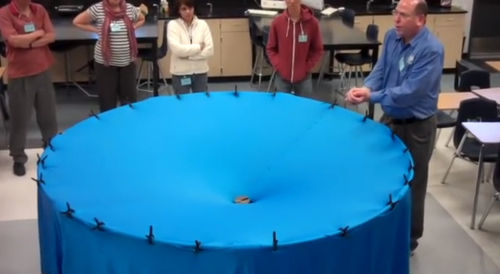
When you place an object on the fabric, the cloth curves. This is exactly what happens in the solar system as well.

The sun with such a huge mass bends the space-time fabric. And the earth and all the planets are kept in orbit by following this curvature that has been made by the sun.
Attributing to the various masses of objects, the way they bend this fabric also varies.
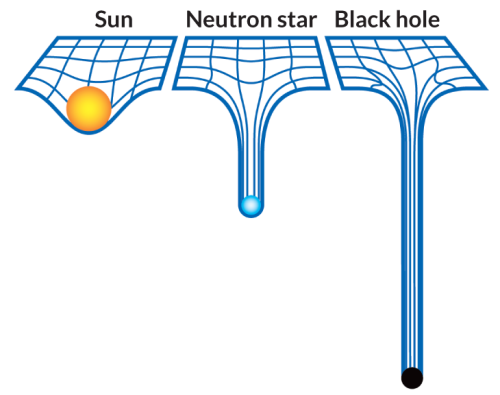
What are Gravitational Waves?
If you drop an object in a medium such as water, they produce ripples that propagate as waves through the medium.

Similarly, Gravitational waves are ripples in space-time fabric produced when you drag heavy objects through space time.
And the nature of these waves is that they don’t require a medium to propagate.
How do you make one?
Everything with mass/energy can create these waves.

Source
Two persons dancing around each other in space too can create gravitational waves. But the waves would be extremely faint.
You need something big and massive accelerating through space-time in order to even detect them.

And orbiting binary stars/black holes are valuable in this retrospect.
How can you detect them?
Let’s turn to the problem to detecting them assuming you do find binary stars/black-holes in the wondrous space to suite your needs.
Well, for starters you cannot use rocks/ rulers to measure them because as the space expands and contracts, so do the rocks. ( the distances will remain same in both the cases )

Here’s where the high school fact that the speed of Light is a constant no matter what plays an important and pivotal role.
If the space expands, the time taken for light to reach from A to B would be longer. And if it contracts, the time taken for it to reach from A to B would be smaller.

PC: PHDComics
By allowing the light waves from the contraction and expansion to interfere with each other, such as done in any interferometry experiment we can detect the expansion or contraction. Voila!
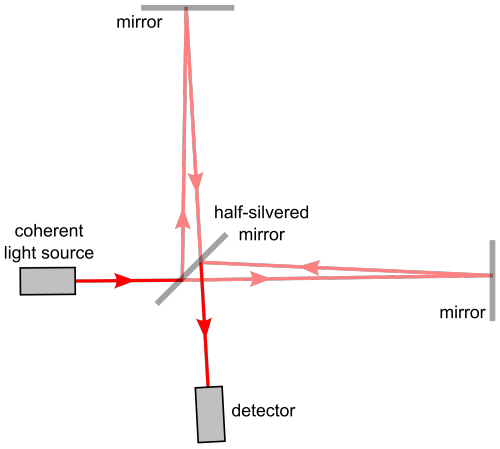
And this is exactly what they did! ( on a macroscopic level ) at LIGO (Laser Interferometer Gravitational-Wave Observatory)
14 September 2015

Two Black Holes with masses of 29 and 36 solar masses merged together some 1.3 Billion light years away.
Two Black Holes colliding is the header animation of the ‘Black Holes are not so Black Series’, in case if you haven’t noticed.

The merger of these two black holes results in the emission of energy equivalent to 3 solar masses as Gravitational Waves.
This signal was seen by both LIGO detectors, in Livingston and Hanford, with a time difference of 7 milliseconds.
And with the measurement of this time difference, physicists have pronounced the existence of Gravitational Waves.
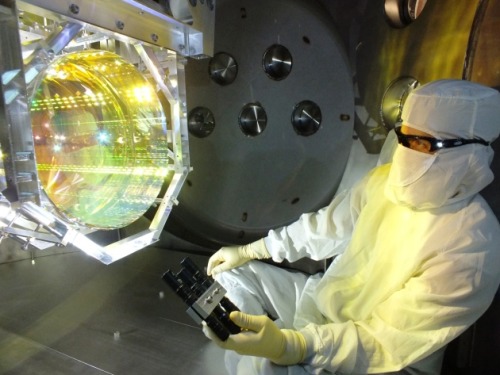
Source
All this is most certainly easily said than done and requires meticulous and extensive research, not to mention highly sensitive instruments.
Had they not have measured this time difference, we might have had to wait for the merger for more massive black holes to collide and maybe even build more sensitive instruments to detect these waves.
And Einstein predicted this a 100 years back!
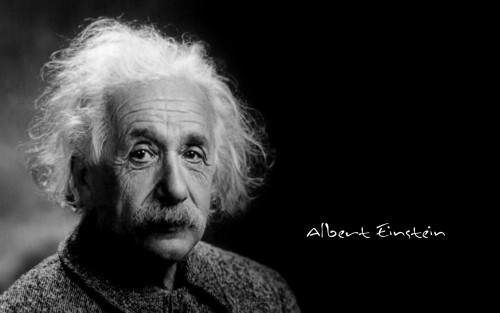
Mind Blown!
Note: Hope you are able to understand and appreciate the profundity of the discovery done by mankind.
** All animations used here are merely for Educational purposes. If you have any issues, please write to us at : 153armstrong@gmail.com

While stuck in traffic in 1961, James Powell, a young researcher at Brookhaven National Laboratory came up with the idea of using powerful magnets to lift and propel massive passenger-carrying cars. Over the next seven years, he and his colleague Gordon Danby spent their spare time piecing together a concept. They obtained a patent for the breakthrough in 1968. Powell and Danby’s magnetic levitation, or maglev, technology must have seemed like magic back then, but it is now being used to move large trains at speeds up to 375 miles per hour!
Not content to rest on this sole accomplishment, the 84-year-old Powell now has grander ambitions for his maglev breakthrough. In 2001, he teamed up with George Maise, an aeronautical engineer and 23-year veteran of Brookhaven National Laboratory, to put forth an idea to revolutionize space launches: StarTram.
Continue Reading.








TODAY IN HISTORY: Behold these beautiful shots of the Earth taken from the Gemini 5 spacecraft on August 25, 1965.
(NASA/ASU)

Meteor impact craters of the world
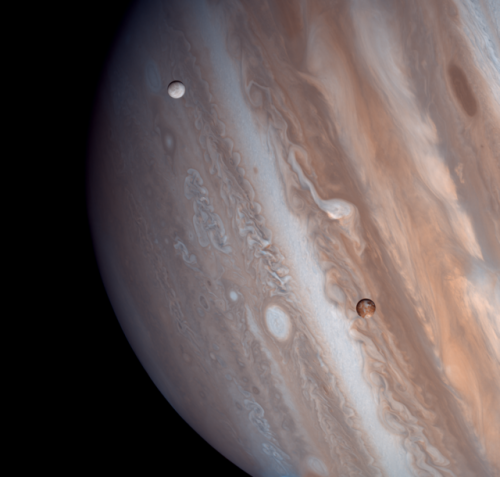
Io and Europa taken by the Voyager 1 spacecraft in 1979
Image credit: Justin Cowart

Comet Lovejoy is visible near Earth’s horizon in this nighttime image photographed by NASA astronaut Dan Burbank, Expedition 30 commander, onboard the International Space Station on Dec. 21, 2011.
Image credit: NASA

An irregular island
This image, courtesy of the NASA/ESA Hubble Space Telescope’s Advanced Camera for Surveys (ACS), captures the glow of distant stars within NGC 5264, a dwarf galaxy located just over 15 million light-years away in the constellation of Hydra (The Sea Serpent).
Dwarf galaxies like NGC 5264 typically possess around a billion stars — just one per cent of the number of stars found within the Milky Way. They are usually found orbiting other, larger, galaxies such as our own, and are thought to form from the material left over from the messy formation of their larger cosmic relatives.
NGC 5264 clearly possesses an irregular shape — unlike the more common spiral or elliptical galaxies — with knots of blue star formation. Astronomers believe that this is due to the gravitational interactions between NGC 5264 and other galaxies nearby. These past flirtations sparked the formation of new generations of stars, which now glow in bright shades of blue.
https://www.spacetelescope.org/images/potw
Density puts things in their proper places.
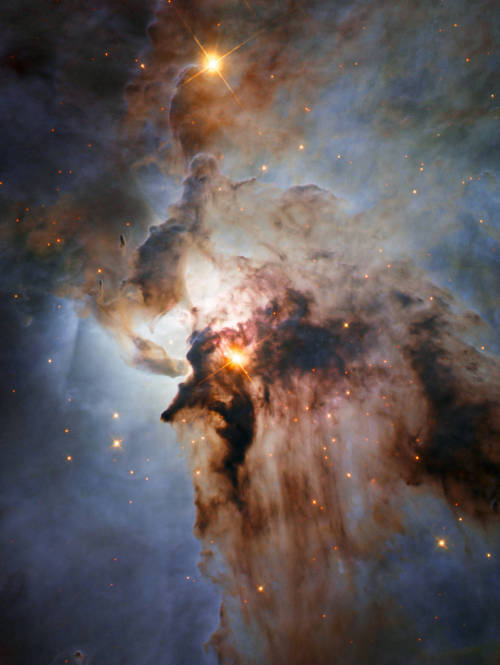
Stormy Seas in Sagittarius
This new NASA/ESA Hubble Space Telescope image shows the center of the Lagoon Nebula, an object with a deceptively tranquil name, in the constellation of Sagittarius. The region is filled with intense winds from hot stars, churning funnels of gas, and energetic star formation, all embedded within an intricate haze of gas and pitch-dark dust.
Image Credit: NASA/JPL/ESA/J. Trauger


What are Pulsars?
Pulsars are spherical, compact objects that are about the size of a large city but contain more mass than the sun. Discovered in 1967, pulsars are fascinating members of the cosmic community.
From Earth, pulsars often look like flickering stars. On and off, on and off, they seem to blink with a regular rhythm. But the light from pulsars does not actually flicker or pulse, and these objects are not actually stars.
Pulsars radiate two steady, narrow beams of light in opposite directions. Although the light from the beam is steady, pulsars appear to flicker because they also spin. It’s the same reason a lighthouse appears to blink when seen by a sailor on the ocean: As the pulsar rotates, the beam of light may sweep across the Earth, then swing out of view, then swing back around again. To an astronomer on the ground, the light goes in and out of view, giving the impression that the pulsar is blinking on and off. The reason a pulsar’s light beam spins around like a lighthouse beam is that the pulsar’s beam of light is typically not aligned with the pulsar’s axis of rotation.
Click here to see the animation
Click here to hear the pulsars sound
-
 unsuredefleur liked this · 1 month ago
unsuredefleur liked this · 1 month ago -
 madebylayza reblogged this · 8 months ago
madebylayza reblogged this · 8 months ago -
 madebylayza liked this · 8 months ago
madebylayza liked this · 8 months ago -
 neuroxdegenerating liked this · 10 months ago
neuroxdegenerating liked this · 10 months ago -
 yolo-bagins liked this · 1 year ago
yolo-bagins liked this · 1 year ago -
 castcastle liked this · 1 year ago
castcastle liked this · 1 year ago -
 itorta liked this · 1 year ago
itorta liked this · 1 year ago -
 moderndaybrando liked this · 1 year ago
moderndaybrando liked this · 1 year ago -
 halfpoisonhalfgod liked this · 1 year ago
halfpoisonhalfgod liked this · 1 year ago -
 rvrx969 liked this · 1 year ago
rvrx969 liked this · 1 year ago -
 dotglobal reblogged this · 1 year ago
dotglobal reblogged this · 1 year ago -
 daughter-of-smoke-and-bone liked this · 1 year ago
daughter-of-smoke-and-bone liked this · 1 year ago -
 ravexandxlust liked this · 1 year ago
ravexandxlust liked this · 1 year ago -
 from-a-distant-end reblogged this · 2 years ago
from-a-distant-end reblogged this · 2 years ago -
 win-44 liked this · 2 years ago
win-44 liked this · 2 years ago -
 6cout reblogged this · 2 years ago
6cout reblogged this · 2 years ago -
 thomasbrisenio liked this · 4 years ago
thomasbrisenio liked this · 4 years ago -
 hummingmoonn liked this · 5 years ago
hummingmoonn liked this · 5 years ago -
 thinkinsboutyou reblogged this · 5 years ago
thinkinsboutyou reblogged this · 5 years ago -
 lunar-candle reblogged this · 5 years ago
lunar-candle reblogged this · 5 years ago -
 queen-of-alagaesia liked this · 5 years ago
queen-of-alagaesia liked this · 5 years ago -
 16fahri liked this · 5 years ago
16fahri liked this · 5 years ago -
 metalzoic liked this · 5 years ago
metalzoic liked this · 5 years ago -
 fortwinks5 liked this · 5 years ago
fortwinks5 liked this · 5 years ago -
 cumberbees reblogged this · 5 years ago
cumberbees reblogged this · 5 years ago -
 cumberbees liked this · 5 years ago
cumberbees liked this · 5 years ago -
 fagdykefrank liked this · 5 years ago
fagdykefrank liked this · 5 years ago -
 guteventfulheroine reblogged this · 5 years ago
guteventfulheroine reblogged this · 5 years ago -
 sapphasea liked this · 5 years ago
sapphasea liked this · 5 years ago -
 nova06 reblogged this · 6 years ago
nova06 reblogged this · 6 years ago -
 nova06 liked this · 6 years ago
nova06 liked this · 6 years ago -
 oriong13 liked this · 6 years ago
oriong13 liked this · 6 years ago -
 malmac liked this · 6 years ago
malmac liked this · 6 years ago
For more content, Click Here and experience this XYHor in its entirety!Space...the Final Frontier. Let's boldly go where few have gone before with XYHor: Space: Astronomy & Spacefaring: the collection of the latest finds and science behind exploring our solar system, how we'll get there and what we need to be prepared for!
128 posts